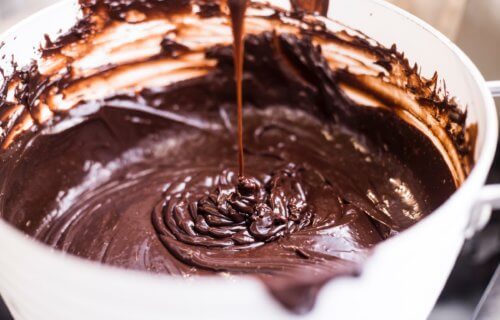GUELPH, Ontario — Cheaper and better tasting chocolate is on the way, thanks to food scientists in Canada finding the secret to making the sweet treat perfectly smooth.
By simply adding a key component of cocoa butter fat, a team from the University of Guelph says chocolatiers can avoid costly tempering that produces the food’s smooth and glossy finish. Globally, people consume more than seven million tons of chocolate annually. In the U.S., Americans eat around 11 pounds of the sweet stuff every year.
Study lead author Professor Alejandro Marangoni believes this technology will help decrease waste and failed batches. Their process maximizes the use of these materials by eliminating the need for complex tempering procedures.
Making chocolate easier to make for smaller shops?
In a statement to SWNS, Prof. Marangoni says this new way of smoothing chocolate can also improve on the carbon footprint of the chocolate making process since it will take less energy requirements to make it work. Study authors expect the discovery will bring the price of chocolate down too, along with making products creamier.
Their study finds it will allow small to medium-sized chocolate makers to produce high-quality chocolate without the use of expensive tempering machines. For chocolate giants of the food industry, changing tempering processes could create an insurance policy against failed batches, improving on the bottom line and their carbon footprint.
Tempering is an expensive and time consuming process that gives chocolate a glossy finish. It involves slowly heating and then slowly cooling it so the fats crystallize uniformly. Afterwards, the chocolate snaps rather than crumbles when consumers break off a piece.
However, the Canadian team discovered they could create a perfect product without the tedious technique master chocolatiers having been employing for decades.
Prof. Marangoni explains that just like when you temper steel, chocolate makers have to achieve a certain crystalline structure in the cocoa butter. This new process allows scientists to add a component that directs the entire crystallization process, guiding it to that same high-quality finish.
So what’s the secret ingredient to perfect chocolate?
Marangoni’s key ingredient, known as a phospholipid molecule, could revolutionize how chocolate is made. The cocoa butter fat component held melted chocolate together and provided the ideal structure faster and at a lower cost. Their discovery, detailed in the journal Nature Communications, could revolutionize the way the chocolate industry operates.
“If you’ve ever eaten bad chocolate, you’ll know it right away. It’s crumbly and grainy and soft. That is chocolate that has not been properly tempered,” Marangoni says in a university release.
Typically, makers will employ “seeding” during tempering to encourage the chocolate to crystallize. Chunks or grated bits of already-tempered chocolate act like magnets to attract loose crystals of fatty acids into line.
“A good chocolatier can do this by eye. Their experience tells them when the chocolate is ready, and they can make adjustments when it’s not. But that can’t be done in large-scale chocolate manufacturing,” Prof. Marangoni adds.
New tempering methods leads to perfect results
Even specialized tempering units are not fool-proof, with large variabilities between batches of cocoa butter. After testing several “minor components,” the researchers identified the phospholipid as the perfect “seed.”
The team screened many minor lipid components that would naturally be present in chocolate and discovered one preferred group. Following that process, researchers added a very specific molecule, a saturated phospholipid, to a mass of chocolate. Those tests produced a deliciously tempered sweet treat. Researchers add that the phospholipid formed a specific liquid crystal structure that seeds the formation of cocoa butter crystals.
Mixing it into melted chocolate and rapid cooling it to 68 degrees Fahrenheit accelerated crystallization without any tempering. A scanner using beams of light millions of times brighter than the sun discovered the resulting chocolate was structurally perfect. Images of its microstructure revealed its gloss and strength in exquisite detail, showing it was good as the best quality chocolate.
Internally, chocolate should be smooth and continuous, not crumbly, resulting in delicious, melt-in-your-mouth decadence. However, this sweet bliss has been very difficult to achieve – until now.
“It’s exciting that you could just add a phospholipid — a natural component already present in the cocoa butter — to achieve the required tempering,” Prof. Marangoni concludes. “This could revolutionize the industry and allow smaller manufacturers to produce chocolate without a big capital investment on machinery.”
South West News Service writer Mark Waghorn contributed to this report.
